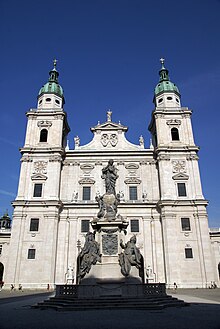Salzburger Dom
| Salzburg Cathedral | |
|---|---|
| Cathedral of Saints Rupert and Vergilius | |
| German: Salzburger Dom | |
 |
|
| 47°47′53″N 13°02′45″E / 47.798056°N 13.045833°ECoordinates: 47°47′53″N 13°02′45″E / 47.798056°N 13.045833°E | |
| Country | Austria |
| Denomination | Roman Catholic |
| Website | www |
| History | |
| Founded | c. 774 |
| Founder(s) | Rupert of Salzburg |
| Dedication |
Saint Vergilius Saint Rupert |
| Architecture | |
| Status | Active |
| Functional status | Cathedral |
| Architect(s) | Santino Solari |
| Style | Baroque |
| Groundbreaking | 1614 |
| Completed | 1628 1959 (restoration) |
| Specifications | |
| Bells | 7 survived 2 (17th century) 5 (1960s) |
| Administration | |
| Archdiocese | Salzburg |
| Clergy | |
| Archbishop | His Excellency Franz Lackner, O.F.M. |
| Laity | |
| Director of music | János Czifra (Domkapellmeister) |
| Organist(s) | |
Salzburg Cathedral (German: Salzburger Dom) is the seventeenth-century Baroque cathedral of the Roman Catholic Archdiocese of Salzburg in the city of Salzburg, Austria, dedicated to Saint Rupert and Saint Vergilius. Saint Rupert founded the church in 774 on the remnants of a Roman town, the cathedral was rebuilt in 1181 after a fire. In the seventeenth century, the cathedral was completely rebuilt in the Baroque style under Prince-Bishop Wolf Dietrich Raitenau to its present appearance. Salzburg Cathedral still contains the baptismal font in which composer Wolfgang Amadeus Mozart was baptized.
Saint Vergilius of Salzburg constructed the first cathedral possibly using the foundations of St. Rupert. The first Dom was recorded in 774. The so-called Virgil Dom was built from 767 to 774 and was 66 metres long and 33 metres wide.
Archbishop Arno (785 – 821) arranged the first renovations of the Dom, less than 70 years after its completion. In 842, the building burned after a lightning strike. Three years later, work began to rebuild the structure.
Under Archbishop Hartwig, the sanctuary expanded to the west with addition of a choir and crypt between 1000 and 1080. Archbishop Konrad I added the west towers from 1106 to 1147.
This original church thus experienced at least three extensive building and rebuilding campaigns during the early Middle Ages, the final result of which was a somewhat ad hoc Romanesque basilica. In 1598, the basilica was severely damaged, and after several failed attempts at restoration and reconstruction, Prince-Bishop Wolf Dietrich Raitenau (Archbishop from 1587–1612) finally ordered it demolished. Wolf Dietrich was a patron and supporter of modern Italian Baroque architecture, having seen it from its origins in Italy and particularly Rome. Indeed, it was Wolf Dietrich who was also responsible for the building of the nearby Alten Residenz, which is today connected to the cathedral.
...
Wikipedia
